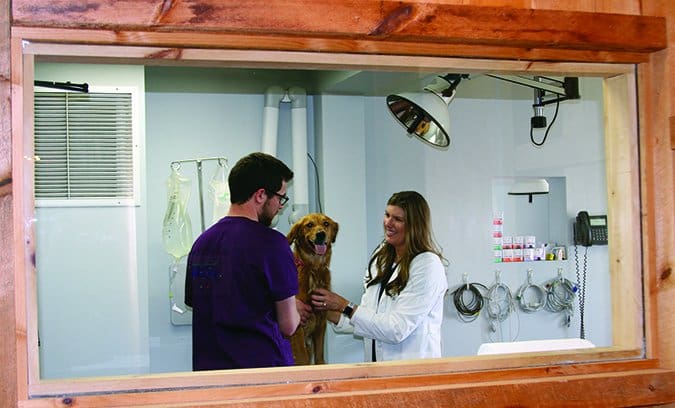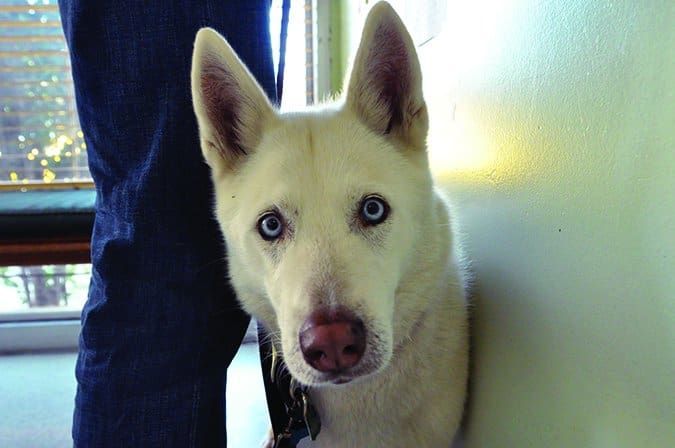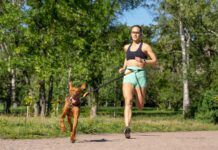We switched to a new veterinarian last year. We made the change on a good friend’s recommendation and could not be happier. Our new vet is thorough, compassionate, smart as a whip, and an outstanding diagnostician. Her staff members are also competent and welcoming. An additional virtue of this clinic is the topic of this article. Our new veterinarian’s standard policy is that owners remain with their dogs and cats for physical examinations and for all health-care procedures that good veterinary practice allows.
Here is an example: Last summer, one of our Goldens, Cooper, developed an ear hematoma. I was away, so my husband, Mike, took Cooper to the clinic.
After an initial examination (conducted with Mike holding and talking to Coop throughout), our veterinarian recommended a relatively new approach to hematoma treatment, in which the site is drained with a large-gauge needle and an anti-inflammatory agent is injected directly into the remaining pocket. It is an outpatient procedure, does not require anesthesia, and is less invasive than traditional treatment protocols. But because it is a sterile procedure, Cooper would need to be treated in the clinic’s pre-surgery room.
Fortunately – amazingly – the vet told Mike that the pre-surgery room has a large observation window, so Mike could watch as Cooper was being treated, if he so desired.
Mike did so desire. As Coop looked back at him through the window (wagging his tail the entire time), Mike witnessed both the procedure and the gentle way in which Cooper was handled and spoken to throughout treatment. After the procedure, the veterinary technician (Cooper’s new best friend), brought Cooper back out to Mike, and they were good to go.
Again, for emphasis: Throughout the entire examination and treatment, Cooper was either with Mike (for weighing, examination, and diagnosis) or Mike could see him through the window (during treatment).

All About Animals
Being in the Room Should Be Standard Procedure
As many dog folks know, this level of transparency and owner involvement is no longer standard practice at many veterinary clinics. It is quite common today for clinics to require that owners relinquish their dog to a staff person while still in the waiting room. All physical examinations, vaccinations, and treatments are then conducted out of sight of the owner in a treatment room and the dog is returned to the owner at the end of the appointment.
I am going to be blunt; I have a strong opinion about this. There is absolutely no chance that I would allow any of my dogs to be taken “into the back” at a veterinary clinic for anything short of surgery. Our new vet does go above and beyond with her clinic’s degree of owner involvement, but we have never been clients at a clinic that required our dogs to be taken away from us for examinations.
Just as I assume that parents would not accept such a policy from their child’s pediatrician, I would not expect owners to agree to be excluded from their dog’s veterinary examination. Yet, this is not only standard protocol in many clinics, but also a requirement of some for acceptance as a client.
Yeah, that’s not going to happen to any of my dogs. I am my dogs’ advocate as well as their source of comfort and security. Our dogs trust us to have their backs and at no time is this more important than when they are nervous or frightened, a common state of mind of many dogs during veterinary visits.
Until recently, this was a matter of opinion. However, a new study, conducted at the National Veterinary School of Alfort in France, examined whether a dog’s stress level during a veterinary examination was influenced by having their owner present and providing comfort*.
*Source: Csoltova E, Martineau M, Boissy A, Gilbert C. “Behavioral and physiological reactions in dogs to a veterinary examination: Owner-dog interactions improve canine well-being.” Physiology & Behavior 2017; 177:270-281.
The Study
The objectives of the study were to measure dogs’ physiological and behavioral responses to a standard veterinary examination and to determine if having the owner present and providing comfort reduced the dog’s level of stress.

A group of 33 healthy dogs and their owners were enrolled. The dogs were at least six months of age and all had previous experience at a veterinary clinic. Heart rate, rectal temperature, ocular (eye) surface temperature, salivary cortisol, and stress-related behaviors were recorded before, during, and after a physical examination conducted in a clinic setting in two distinct conditions:
1. Contact: The owner stood next to the examination table at the dog’s side and comforted the dog by gently petting and talking to him or her quietly.
2. Non-contact: The owner was in the room, but did not interact with the dog and sat quietly in a chair located about 10 feet away from the exam table.
A balanced, crossover design was used. This means that each dog experienced two visits (timed one to two weeks apart) and was subjected to both conditions. To control for an “order effect,” the sequence of the conditions varied and was randomly assigned. Examinations lasted about five minutes and included mild restraint, examination of the dog’s eyes, ears, mouth, and teeth; palpation of the lymph nodes and abdomen; manipulation of joints; and heart and lung examination with a stethoscope.
Results
Unsurprisingly, veterinary visits are stressful to dogs:
Waiting Room Stress
All of the dogs experienced at least a low-level of stress during the pre-examination period in the waiting room. As they waited, many of the dogs showed frequent yawning, which is considered to be a displacement behavior during periods of emotional conflict. Some of the dogs also whined and vocalized.
Examination Stress
The researchers found that all of the dogs, whether or not their owner was comforting them, showed a measurable stress response during the veterinary examination. Heart rate, ocular temperature, and lip-licking all increased during the examination period.
Owner Being There
When owners stood close to their dogs and provided comfort by talking to and petting them, the dogs’ heart rates and ocular temperatures decreased when compared with the condition in which owners were not interacting with their dogs. Both of these changes are associated with a decrease in stress. Dogs also attempted to jump off of the examining table less frequently when their owner was providing them with comfort than when the owner was not comforting them.
The authors conclude: “The well-being of dogs during veterinary visits may be improved by affiliative owner-dog interactions.”
Up On My Soapbox
I know, these results are a no-brainer for many dog folks: Veterinary visits are stressful to dogs and being present to comfort and reassure our dogs reduces their fear and stress.
Unfortunately, in my view, this study did not go far enough, since it did not study the condition that I am most interested in learning about: when dogs are taken away from their owners and examined out of the owner’s presence.

Interestingly, the argument that is made to support this practice at the clinics that insist upon it is that they remove dogs from their owners because the presence of the owner can cause the dog to be more stressed, not less so. Well, at the very least, these results provide evidence against that excuse.
And – an excuse it truly is. Perhaps this sounds harsh (remember, I am standing on a soapbox!), but my belief is that these policies are in place more for the convenience of the clinic than for the benefit of the dogs. No doubt, reducing client interactions in an examination room is more expedient and efficient (for the clinic).
And, there is also that pesky issue of transparency. An owner who does not have the opportunity to witness how her dog is handled, spoken to, examined, or treated cannot question or criticize. There is really no other way to say this: The risk of owner displeasure and complaints is reduced by not having owners present while dogs are being examined and treated.
So, personally, I am happy to see these results, as they can be used as evidence when responding to a clinic that insists it is less stressful for dogs to be removed from their owner during examinations and routine procedures. Petting and talking to our dogs when they are upset during a veterinary visit reduces their stress. We have the data. (Not to put too fine a point on it, but these results also provide more ammunition to combat the still-present [and false] belief that calming a fearful dog “reinforces fear.” I address that particular issue in more depth in my book, Dog Smart).
Hopefully, we will see a follow-up study that examines dogs’ responses to “no owner present” policies. Regardless, the data that we currently have encourage us to stay with our dogs during veterinary visits and examinations. It is quite simple really: Just. Be. There. Insist upon it.
Linda P. Case is the owner of AutumnGold Consulting & Dog Training Center in Mahomet, Illinois. Linda is the author of Dog Food Logic, has a new book, Dog Smart, and writes The Science Dog blog.






Thank you so much for talking about your findings on how effective it is to have the owner be in the room during a vet visit. My dog is a very clingy one, and it would often rush back to me if ever it found something that it’s not familiar with like an insect or a new household item. Since it’s this attached to me, I’ll make sure that I stay with it when I take it to a pet hospital for its regular checkups.
So odd that you refer to your dog as “IT”.
Thank you for printing this article. Too many clinics, including most clinics that specialize in cancer, orthopedic surgery, etc., insist on taking the dogs to the back. I agree. This is not acceptable. Great read!
Most if those specialty clinics (especially oncology) require extremely sterile environments and use dangerous drugs. The less exposed personnel the better. Routine exams are one thing. But often times treatments require unpleasant procedures that owners unfamiliar with the medical field are not prepared for. Not to mention many people who don’t understand rather than ask questions will make assumptions and blast the practice. (Like routine SAFE restraint being described as “choking”) Not to be confused with actual choking where the patient can’t breathe. Also most owners want to get in the pets face and they become a liability. And no. The vast majority of owners do not listen when you tell them to back off for their safety. “He would never hurt me” turns into “I can’t believe my dog just bit me” Most people that own dogs don’t truly understand dog behavior.
Great comment ! There are very few “problem” dogs … way too many “problem” people …
Luckily the no-owner-present protocol is very uncommon in my parts. But it is common to hand over your pet, prior to an operation. Having heard/read my share of stories of pets never making it out of anaesthesia alive, I will always do what ever I can to make sure I stay with my pet until the initial sedative has taken effect. Should the unexpected happen and my pet dies during the procedure, I’m not sure I’d ever forgive myself, if I knew I could have held him/her in my arms as they fell asleep from the sedative.
I agree with this 100 per cent. But in my case the only vet emergency clinic within 2 hours of me insists on taking your pet to the back for assessment and treatment, siting liability issues. And they have no qualms about kicking you out if you argue. So I’m kind of over a barrel if I need emergency care for my pets. I have no arguments about the quality of care they provide. It’s just that I know my dogs would be much more comfortable with me.
Liability issues. That’s a blanket statement of nonsense. WHAT is the liability…that you’re liable to see them mistreat your pet?
The liability issue is that emergencies are often high stress for patient and client. Emotions are running high and people tend to cause commotions. The dogs feed off the stress and if you get bit trying to involve yourself you can sue the clinic. It’s not a blanket statement. You dont have time to vet every person as reasonable or not and you can’t predict how people will react in situations. So for the safety of everyone you’re not allowed. Plus painful dogs/cats are more likely to bite out of fear.
Yes, as a pet owner, I , totally,agree. Clients insisting staying with their pet, during an emergency ( and non emergency) is a huge liability and distraction to all staff and inhibits safe procedures! It’s common sense and all about safety of the staff,client and the pet!
Why are you taking your pets to a vet that you think might mistreat your pet?
Why do you think someone would get into a field where they’re paid barely anything for doing a highly skilled job? Do you think it’s because they love animals? Or do you think they just want to mistreat a pet?
Listen to yourself.
Jessica, I don’t think that pet owners have a clue that their pet might be mistreated by a particular vet or tech! The pet’s owners are possibly misled by a pleasant, front desk, and the vet’s, etc, attitude with them, the paying customer, and have no knowledge that sometimes this is just a “front” and actually can misrepresent the vet. So it’s extremely naive not to be aware that mistreatment of animals by vets and techs does definitely sometimes take place. Not all vets retain the good feelings over the years that may have drawn them into their profession at the start.
100% correct. I used to work for a vet and he did mistreat the animals, it’s why I quit and made sure everyone knew this as well!
This article is going to create problems for veterinarians following cdc protocol in regards to Covid-19. Just figured I would point that out.
Thanks captain obvious. That’s what masks are for. Just figured I would point that out.
HERE HERE GInger Red!!
My vet clinic started this due to cdc protocol. They still are doing this. So, we start a new vet next week who will lets us stay with our pups during exams, vaccines, etc. I love WDJ
A couple years ago we had to put down a dear sweet friend of ours who had bone cancer. I/we made the mistake of allowing the vet’s assistants to take her out back “for prep”. As it turns out, she was given a very heavy sedative just prior to them trying to return her to us. She never made it out of the back room door before she collapsed, all fours spreadeagled on the floor. I have never been as angry at another human being in my life as I was at that time. We were robbed of our ability to say good bye to our beautiful love, Tamaya. Never again.
My experience – handling over 100 dogs per week – grooming not vet, the owners bring an un-necessary level of “emotion” to the party … let the professionals do what they do all day long – their job.
Thank you! Vets are not mistreating pets when away from owners!
Absolute BULL Sara, I had to let myself into the back room of a vet office where six people had my therapy dog certified Great Dane surrounded, one tech was screaming at him, all because he didn’t want to eat their crappy canned food for a test. They never once brought him and the food back to me to see if I could get him to eat it.
My ancient senior, after the tech refused to let me into the back and me telling the tech THREE times to be careful because she slipped quite easily, came back to me with a bleeding mouth because she supposedly “slipped” while getting an x-ray.
I also saw a tech literally toss a pit bull that still had drains hanging out of wounds into the back of a pickup truck so hard that the dog slid across the bed and hit the back of the truck cab.
None of these events were accidents, they were abusive events and they do happen.
Stop lying Sara, I have seen it myself, and I use to be a vet tech
My Vet has always allowed me to be with my dogs. Love Love Love him and he is getting ready to retire. The local “Specialty” Vets in Akron Ohio take the dogs in the back and have owners wait in the reception area. NOT ACCEPTABLE!!! And these are Specialitst! There should be a law against this!
No there shouldn’t. Specialists are often providing a higher level of care than routine veterinarians with specialty equipment and higher sterility requirements. Clients bring an added security risk. And track in all manner of pathogens.
Any medical professional that follows cdc masks etc. Mandates is to stupid to be trusted to provide medical treatment to my dogs. Look how many unneeded vacines are being promoted as well as dry food. Follow the money. It’s like castration/ nutering. Way to casual, lack of hormones cause weakend physiology, particularly for males but females are effected also. Any time we change what nature designed we should think seriously before we pull the trigger.
You seem like the kind of person who only takes your dog to the vet when the expired penicillin isn’t curing the mangled leg and internal bleeding.
I’m sorry, but you seem to forget that there ARE dogs who are better off in the back room. My now deceased heart dog, Ducky, is one. As long as I was where she could see me, she was extremely stressed because she couldn’t “protect” me. But once in the treatment area – where she couldn’t see me – she relaxed and allowed the vet and staff to do whatever they needed to do. I knew she was in good hands, and I was never worried that she would be mistreated. I am still friends with those vets, and I will take future dogs to them. I also won’t hesitate to allow the dogs to be taken to the back. They are a fear free practice.
As a vet tech, I’m very confident in saying that you are wrong, on many levels.
You should find a clinic that does what is best for your dog, not what makes you most comfortable. Those don’t go hand in hand a lot of the time. Most dogs do better away from their owners. Not only are they stressed for themselves, they’re also worried about you. You said yourself that the study doesn’t show how dogs do separated. You know who DOES see that every day? Vet techs.
Find yourself a vet that cares and works with your animal to find out what makes them the most comfortable, AND keeps everyone safe. If a dog does better with mom, we will put that note in the chart so that everyone knows and we can keep that in mind. If a dog does better away, we will also be putting that in the chart. But you putting your hands all over your dog while I am trying to prevent my doctor from getting bit, or trying to hold in a specific way so they can do their orthopedic exam, or hear their heart, is impeding MY ability to properly do MY job. Which is to help my DVM do their job, which is to make sure your pet is healthy. Another part of my job is to make sure they don’t get hurt. Do you know how many times I’ve heard an owner say “oh, he won’t bite,” just for THEM to get bitten/scratched, because they want to put their hands and their face in front of their stressed pet? Because THEY think they know better than someone who does this every. Single. Day?
We don’t take the pet to the back SIMPLY because it’s easier. We do what is best for the pet. We’re in this field BECAUSE we love animals. We get paid next to nothing to do a combination of like EIGHT different human med field jobs. So we’re definitely not in it for the money, and we’re not in it for something “easy.” We’re in it for the animals. No tech or vet is taking your animal to the back so they can mistreat your pet.
And the groomers are the worst ones that also abuse the animals, saw it myself, I actually had to call the police on them and YES they were charged with animal cruelty
I am a first time dog owner. My pup gets carsick quite easily so I chose a highly recommended vet that is a 4 minute drive from my house. Unfortunately this vet has the tech hand over the dog in the parking lot due to covid. They are all in masks when they come outside so I can only assume there is a severe immune compromised person on staff. I’ve thought about changing so I can go inside or at least see the vet in person rather than only talk to him on the phone but being that my pup gets carsick for a 4 minute drive I don’t want to make it worse by driving further to another vet. I’m very conflicted.
I do believe that there really aren’t any “hard and fast” rules on this subject. It depends on the dog, it depends on the owner, and it most definitely depends on the individual vet, the clinic’s staff, and the techs which is the best thing to do. Unfortunately though, there are vets and techs who do a very poor job, and have, and do injure pets in their charge. Often it seems out of sheer impatience with the innocent animals. There was such a case in a high end, suburban area, Rye, New York, only a few weeks ago. The vet’s carelessness resulting in some injuries and possibly even untimely deaths had gone on for some time before one of his staffers finally brought it to light. At that time the clinic was closed down, and the vet seemed to go into hiding.. So due diligence by pet owners is necessary, thoroughly research the vet, and the clinic where you plan to bring your pet for any treatment. Personally, I’ll only go to a vet who allows and welcomes my accompanying my dog for all of his routine, regular veterinary visits, exams and treatment.
Well, if they don’t want you in the back because it’s better for the pet, what about having a camera so the owner can see what’s going on and feel more comfortable? We have cameras everywhere now and I think that would help alleviate some peoples’ concerns while still allowing the pet to be away from the owner when necessary.
Yes I’d agree to this
I have been on both sides of the equation. I was a Veterinary Assistant so understand the stress pet parents can bring inside the room. But good Assistants can alleviate that stress by communicating what is needed and taking care by restraining the dog/cat in a calm manner.
I have also gone elsewhere because a local Vet office would not let me come back with my dog for basic vaccinations.
I’m going to have to disagree. They always take my dog in the back of the clinic because she dies better when I’m not there. She is constantly trying to protect me and is dog aggressive. They said she acts totally different when I’m not in the room. She doesn’t cause drama. I don’t hear her make a noise in the back and I do listen. So I just trust it’s all okay. Especially when she is 93 pounds and they are secreting anal glands. No sound. If she was in distress I know I’d here her. She gets upset over a cat being in the yard.